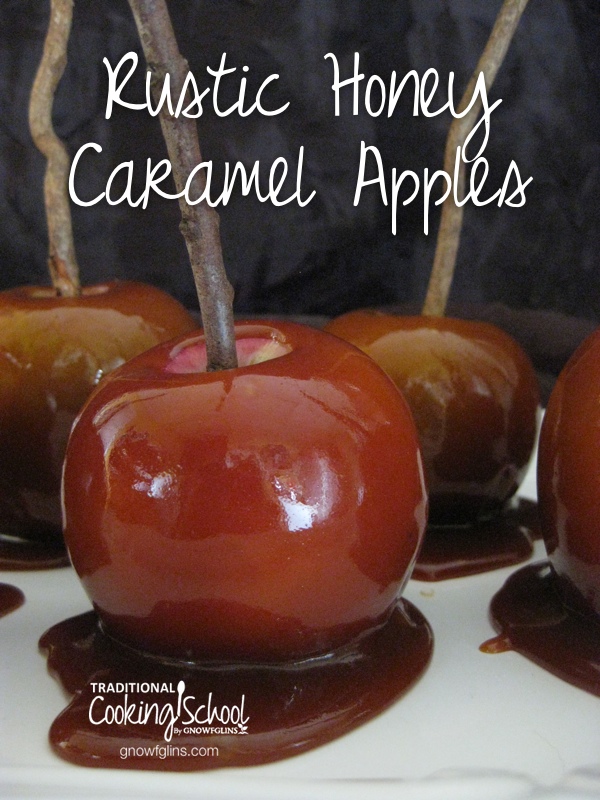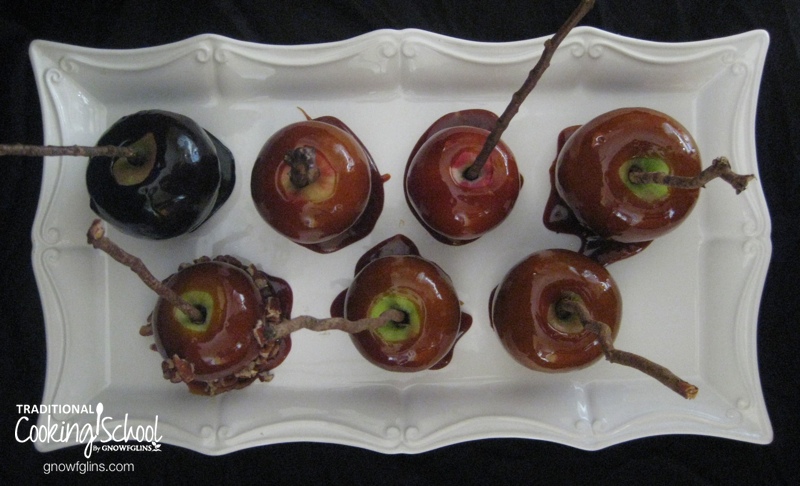
There are certain flavors that just sing of autumn.
Cinnamon, nutmeg, cloves, pumpkin, apple cider, honey….
Just think of a homey kitchen that’s cozy and comforting when you come in from the cool, autumn night and that’s full of heady, rich spices — these scents that sing their way into your soul.
Thus, because I wanted an excuse to make something with apples, because I wanted an excuse to fill my kitchen with autumnal scent, and because I wanted to provide a sweet treat for my kiddos as an alternative to the processed-sugar laden options that oppress us at this time of year, I decided to make these Rustic Honey Caramel Apples, complete with gathered sticks from our yard to give them a rustic feel.
We love these honey caramel apples, but I will admit — sometimes eating a whole one can be a bit overwhelming AND rather messy, especially for my youngest preschool-aged kiddos, so I often cut the apple into sections and serve the caramel by itself as a Honey Caramel Dip. (If you’d like a slightly softer caramel dip, check out the honey caramel I make to serve with apple cider.)
But then again, I love the whole honey caramel apples too, because — just look at them! — they look so cool and just plain fun to eat.
As for the spices, you may notice that there aren’t any of the aforementioned spices in this recipe, although they do boast apples and honey, of course. I tend to have apple cider with a few cloves and a cinnamon stick simmering on the stove while I make these apples — or, if apple cider isn’t available, I just fill a deep saucepan or a small slow cooker with water and add the cinnamon and cloves to that, just to fill my kitchen with scent. It’s really quite lovely and I swear it makes the honey caramel apples taste even better!
Happy fall to you and may you have many cozy nights with people you love!


Rustic Honey Caramel Apples
Ingredients
Instructions
-
First, line a baking sheet with parchment paper or a silicone mat.
-
Set aside.
-
Next, wash your apples and push a stick into the center of each one.
-
Have them at the ready.
-
Place the honey, cream, and salt in a large, heavy-bottomed saucepan and bring to a boil over medium-high heat. Be aware that the mixture will very likely quadruple or quintuple in size as it cooks during this first phase, so use the largest pan you can maneuver comfortably.
-
Reduce the heat to medium or medium-low (choose the highest temperature you can without bubbling the mixture over), clip on a candy thermometer if you have one (this one is by far my favorite), and let the mixture simmer until it reaches between 255°F and 260°F, hard-ball stage.
-
To determine if the honey caramel is at the desired temperature, I recommend testing the caramel two ways (not one of two ways, but two ways, as in - do both!).
-
First, use a candy thermometer if you have one. However, sometimes they need a bit of calibrating and aren't exactly accurate. (I completely burned the first batch of caramel apples I made to photograph for this article because I had a new thermometer that I hadn't checked!)
-
Thus, I also always do The Cold Water Test. This is also the most accurate way to determine your caramel's readiness if you don't have a thermometer.*
-
When your honey caramel has reached the desired temperature, remove from the heat and tilt so that all the caramel forms a deep pool at one end of the saucepan.
-
Dip and twirl each apple to coat completely, then let extra caramel drip from the apple and set on the prepared baking sheet to cool and harden.
-
Once all apples have been dipped, you may redip them if desired.
-
Let stand for at least two hours before serving.
-
Store in a cool, dry place for up to three days.
Recipe Notes
*To do the cold water test, simply have a small bowl, such as a cereal bowl, full of very cold water next to your work area. When you want to test the caramel, scoop a small amount of caramel out and drop it in the water. After a few seconds, take it out with your hands and press it lightly between your thumb and forefinger. If it's firm, but still very maleable, it's ready. Another visual confirmation is that the caramel will cling to the back of a spoon that's dipped in it and will run off in thick threads. You can see photos of this at The Science of Cooking.
You're welcome to heat the caramel to a higher temperature - and in fact, you may be tempted to, as the mixture still looks quite thin at 255°F - but you should know: the higher you heat it, the more brittle your candy coating will be, which may or may not be desirous. Also, it will also peel off your apple more readily rather than cling to it and may, in fact, slowly slide right off over the course of a day or two if left to sit in any humidity whatsoever. This is thanks to the fact that we're using honey rather than a crystalline sugar, but the upside is that honey caramel tastes better. 🙂 To decide how brittle you'd like your coating, see this article on the stages of candymaking.

What flavors and scents do you love most about Fall? And more importantly… how do they find their way into your cooking?
This post was featured in 52 No-Junk Candy Recipes.
We only recommend products and services we wholeheartedly endorse. This post may contain special links through which we earn a small commission if you make a purchase (though your price is the same).


Well, this is just beautiful! (Too bad I don’t like caramel apples!) Great photography, Kresha!
I love caramel apples! These are beautiful!
These sound delicious! Thank you for this recipe! I was looking for a more natural alternative for caramel apples and this is perfect! The sticks are a great idea too.
I’m so glad! I hope you enjoy them as much as my kiddos and I do. 🙂
This looks soooo good. I love carmel apples.
I have to say something to your readers tho. Please, be sure the twigs you use are not from poisonous plants. My dad tells me a story about the CA beaches. Originally, they landscaped with Oleander bushes. (we’re talking 1940’s and 50’s) They had to take them out after several incidents where folks thought they would make great hot dog roasting sticks; and after using them, became quite ill or worse. Oleander is very poisonous when used to toast marshmellows or roast hot dogs! I suspect there may be other plants as well. Most trees are probably safe; but there are some trees that have poisonous parts. Just check online to be sure that what you’re using is not a poisonous plant.
I’m an avid gardenerer, and I don’t want to start one of those trends where people suddenly dislike a plant due to it’s toxicity. Generally, these poisonous plants are great detoxifiers to their environments. Their benefits go unseen, but are sorely needed in today’s world; and people really seldom do have issues due to the poison in plants. Unless… you start eating them, cooking with them, etc…
That’s an excellent reminder – thank you!
i love caramel apple season….but i look forward to the chopped toasted nuts on them most. it adds an extra dimension of taste, health, and beauty. i like your recipe and caramel making tips….but you can’t leave out the nuts!
You’re so right! I added them in the photos on some of the apples, but I totally forgot to mention them in the article. :-/
I prefer pecans – what is your favorite nut to use, Christy?
Can you substitute maple syrup for the honey? Would it be the same amount? Can’t wait to make this the kids really wanted candy apples but we do not allow them to have refined sugar
If you buy the raw organic honey there is no refined sugar just natural goodness
Thanks for the ideas on apples.
Can you store the left over caramel? I’d like to use this for chocolates, but am not sure of quantity and don’t want to waste it.
I’m wondering how the taste differs from the regular caramel using brown sugar. I was thinking of gifting but the folks i am giving too aren’t on the traditional foods path. 🙂 and any thoughts as to how this would fare if I used sucanat?
Any ideas on what to use instead of Heavy cream- We can’t have dairy here 🙁
Several of my friends who eat dairy-free make caramel using coconut milk, so in this case I would assume coconut cream would work beautifully. I haven’t tried it, but there is certainly plenty of precedence for it, so I would say go for it! 🙂
Enjoy!